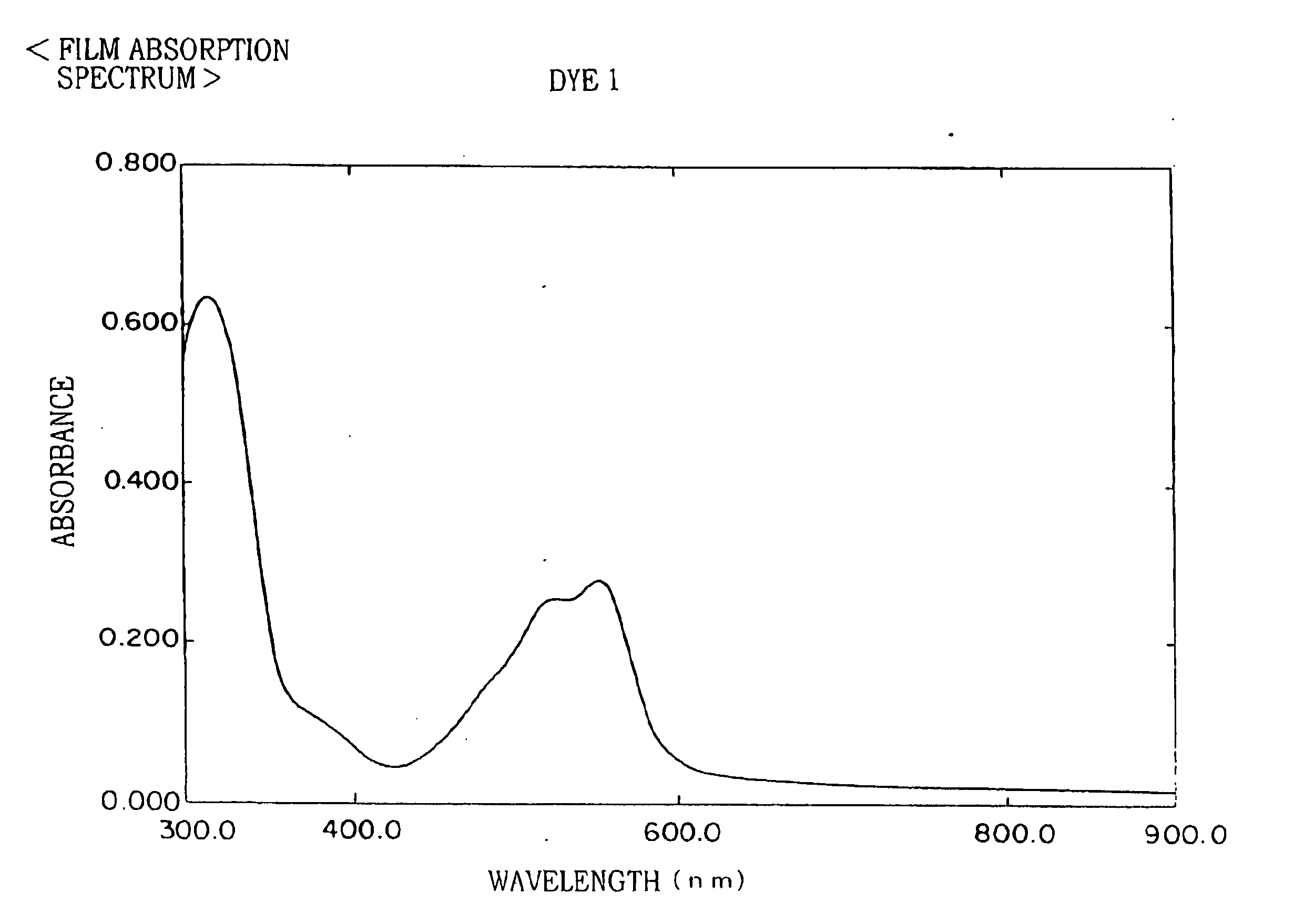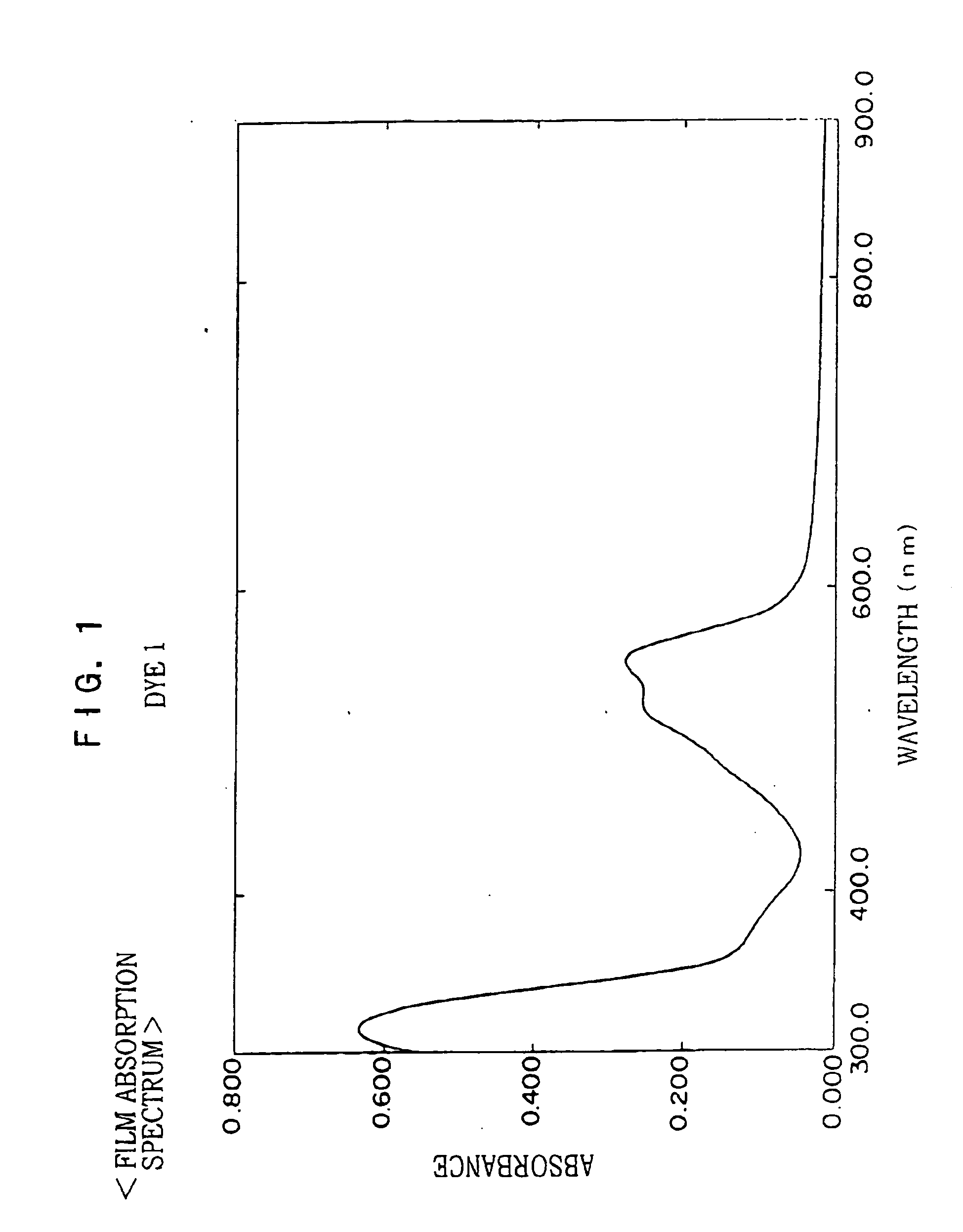Optical information recording medium
a technology of optical information and recording medium, which is applied in the direction of instruments, photomechanical equipment, thermography, etc., can solve the problems of insufficient recording capacity to cope with future needs, unsatisfactory storage stability of disks, and the inability to produce optical disks using dyes with this production method including coating, etc., to achieve excellent recording characteristics, improve dye solubility, coatability, and the effect of drying load
- Summary
- Abstract
- Description
- Claims
- Application Information
AI Technical Summary
Benefits of technology
Problems solved by technology
Method used
Image
Examples
example 1
Evaluation of Optical Disk (Optical Information Recording Medium)
[0137] A substrate having a thickness of 1.1 mm was made from a polycarbonate resin (Panlight AD5503) manufactured by Teijin Chemicals Ltd. by injection molding. The track pitch of grooves on the substrate was 320 nm, the half width of the portions on the grooves was 110 nm and the depth of the grooves was 35 nm.
[0138] A reflecting layer having a thickness of 100 nm was formed on the substrate by using a target containing Ag (98.1 parts), Pd (0.9 parts) and Cu (1.0 part) by a vacuum filming method.
[0139] Next, dye 1 was weighed such that the amount of the dye was 2.5 g with respect to 100 ml of TFP and the weighed dye 1 was mixed with TFP. Ultrasonic wave was applied onto the resultant mixture for 2 hours to dissolve the dye in the solvent and then the resultant solution was allowed to stand under an environment of 23° C. and 50% humidity for at least 0.5 hours. Then, the solution was filtered with a filter having ...
examples 2 to 11
, and Comparative Examples 1 to 6
[0143] Optical information recording media of Examples 2 to 11 and Comparative Examples 1, 3, 5 and 6 were manufactured or attempts to manufacture optical information recording media of Comparative Examples 2 and 4 were conducted and evaluated in the same manner as in Example 1 except that dyes described in Table 2 were used in place of dye 1 of Example 1, respectively.
Comparative Dye B
Comparative Dye C
Comparative Dye D
(Compound 1-1 Described in JP-A No. 2001-253171)
Comparative Dye E
(Dye (12) Described in JP-A No. 2002-2117)
Comparative Dye F
(Dye (1-1) Described in JP-A No. 2002-301870)
Evaluation of Light Fastness
[0144] A light-fading test was conducted for the manufactured optical information recording media by using a 100000 Lux Merry-go-round type light-fading tester. The optical information recording medium was irradiated with light for 3 days without using a UV filter. The residual rate was obtained from the transmission c...
PUM
| Property | Measurement | Unit |
|---|---|---|
| Nanoscale particle size | aaaaa | aaaaa |
| Nanoscale particle size | aaaaa | aaaaa |
| Nanoscale particle size | aaaaa | aaaaa |
Abstract
Description
Claims
Application Information
 Login to View More
Login to View More - R&D
- Intellectual Property
- Life Sciences
- Materials
- Tech Scout
- Unparalleled Data Quality
- Higher Quality Content
- 60% Fewer Hallucinations
Browse by: Latest US Patents, China's latest patents, Technical Efficacy Thesaurus, Application Domain, Technology Topic, Popular Technical Reports.
© 2025 PatSnap. All rights reserved.Legal|Privacy policy|Modern Slavery Act Transparency Statement|Sitemap|About US| Contact US: help@patsnap.com



